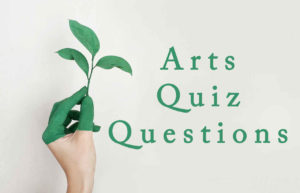Arts Quiz Questions and Answers

ULTIMATE ART QUIZ – Arts Quiz Questions and Answers Part 1
From symbolism to sculpture, this quiz will put you in touch with your artistic side.
1) Which of these is a paint made from pigments and plastic?
A) Acrylic
B) Gesso
C) Acetone
D) Tempera
Answer: A
An acrylic paint is water-soluble, and made from pigments with a plastic binding agent.
2) Early photographers made their images on which of these materials?
A) Glass
B) Stone
C) Paper
D) Plastic
Answer: A
Early photographers applied light-reactive chemicals to fragile glass plates and exposed them to light to make images.
3) To which artistic movement does Paul Gauguin’s The Yellow Christ belong?
A) Impressionism
B) Bauhaus
C) Cloisonnism
D) Fauvism
Answer: C
French painter Paul Gauguin was one of the earliest practitioners of cloisonnism, a post-Impressionist style characterized by vivid areas of color separated by dark contour lines.
4) What does the Venus of Brassempouy represent?
A) a woman’s head
B) an angel
C) a human figure
D) an old man
Answer: A
The Venus of Brassempouy is one of the oldest known representations of the human head. It is a fragment of what was once a larger figurine, and is probably about 25,000 years old.
5) Which architect founded the Bauhaus school of design?
A) Walter Gropius
B) Frank Gehry
C) I.M. Pei
D) Frank Lloyd Wright
Answer: A
The Bauhaus school of design was founded in 1919 by architect Walter Gropius.
6) Who designed the Vietnam Veterans Memorial?
A) Henri Matisse
B) Maya Lin
C) Frank Gehry
D) Frank Lloyd Wright
Answer: B
Maya Lin, an American sculptor and architect, created the Vietnam Veterans Memorial in Washington, D.C.
7) What did I.M. Pei design outside the Louvre, in Paris?
A) Sarcophagus
B) Obelisk
C) Ziggurat
D) Pyramid
Answer: D
Made of glass and metal and designed by I.M. Pei, a pyramid stands before the Louvre, the famed museum in Paris, France.
8) Which one of these is not a well-known Indian sculptor?
A) Ramkinkar Baij
B) Henry Moore
C) Kumaradeva
D) Krishna Reddy
Answer: B
Henry Moore was a famed English sculptor. The other three are among the many famed sculptors of India.
9) What animal often symbolizes peace in art?
A) Dog
B) Duck
C) Deer
D) Dove
Answer: D
The dove represents peace in many artworks. Pablo Picasso, for example, painted a dove for the World Peace Conference held in 1951.
10) What was the subject of the earliest known paintings?
A) Animals
B) Landscapes
C) Sports
D) Flowers
Answer: A
The paintings in the Lascaux caves in France of 15,000 years ago were of bison, antelope, mammoths, and other migratory animals.
ARTISTS, PAINTERS, & ARCHITECTS – Arts Quiz Questions and Answers Part 2
Who picked up a paintbrush, chisel, or piece of clay to create the world’s most famous works of art? Draw on your knowledge of well-known artists to find out.
11) What Dutch artist is famous for his strange geometrical puzzles?
A) M.C. Escher
B) Pieter Breughel
C) Vincent Van Gogh
D) Jan Van Eyk
Answer: A
M.C. Escher (1898-–1971), a Dutch artist, is known for lithographs and woodcuts that use realistic details and geometry to create bizarre conceptual and optical effects.
12) Which of these artists is famous for using human paintbrushes?
A) Paul Cezanne
B) Yves Klein
C) Giorgio Vasari
D) Jackson Pollock
Answer: B
For French artist Yves Klein’s “living brush” paintings, created from the 1950s onward, paint-covered live models pressed themselves against his canvases, leaving impressions of their bodies.
13) Which of these artists used musical terms such as “nocturne” and “harmony” to describe his pictures?
A) Vincent van Gogh
B) Leonardo da Vinci
C) Edgar Degas
D) James Whistler
Answer: D
To emphasize the analogy between color and music, James McNeill Whistler borrowed musical terms—such as nocturne, arrangement, symphony, and harmony—to describe his paintings and etchings.
14) Who was the first famous artist of the Italian Renaissance?
A) Michelangelo
B) Mantegna
C) Masaccio
D) Leonardo da Vinci
Answer: C
The man whom many consider to be the first great painter of the Florentine Renaissance died when he was only 26. His name was Masaccio.
15) With what painter did Jean-Michel Basquiat collaborate?
A) Roy Lichtenstein
B) Andy Warhol
C) Claude Monet
D) Willem de Kooning
Answer: B
The young Jean-Michel Basquiat was befriended by the Pop artist Andy Warhol in 1983, and the two began to collaborate occasionally.
16) Which artist is best known for her large-scale paintings of poppies?
A) Judith Leyster
B) Georgia O’Keeffe
C) Joan Miro
D) Annie Leibovitz
Answer: B
Georgia O’Keeffe, one of the most famous American painters of the 20th century, created numerous close-up portraits of poppies and other flowers.
17) Which of these painters did not work during the Renaissance?
A) Titian
B) Michelangelo
C) Raphael
D) Salvador Dali
Answer: D
Salvador Dali was the creator of playful, surrealistic paintings. He was a 20th-century Spanish artist. The other painters worked during the Renaissance.
18) Which of these was not a Renaissance artist?
A) Henry Moore
B) Michelangelo
C) Raphael
D) Leon Battista Alberti
Answer: A
Henry Moore, the English sculptor, was active in the 20th century, long after the Renaissance ended.
19) What did Jan van Eyck paint on, mostly?
A) Wooden panels
B) Canvas
C) Glass
D) Cotton
Answer: A
The Flemish painter who perfected the new technique of painting in oils, Jan van Eyck produced mostly portraits and religious subjects on wooden panels.
20) Which of these artists made a well-known drawing of Don Quixote?
A) Jan van Eyck
B) Rembrandt
C) Pablo Picasso
D) Paloma Picasso
Answer: D
Pablo Picasso, the Spanish artist, made an ink drawing of the literary figure Don Quixote in 1955. It has become one of the most famous images of the Spanish knight-errant.
DANCE – Arts Quiz Questions and Answers Part 3
From the graceful movements of ballet to the flapping frenzy of the Charleston, tap your feet—and scratch your head—in this study of dance.
21) How many foot positions are there in ballet?
A) 5
B) 17
C) 10
D) 1
Answer: A
There are five basic positions of the dancer’s feet. They are characterized by the way the dancer’s feet point outward, and they are balanced by matching positions of the arms and head.
22) Who founded the Ballets Russes?
A) Frederic Chopin
B) Sergey Diaghilev
C) Pyotr Tchaikovsky
D) Mikhail Baryshnikov
Answer: B
Sergey Diaghilev founded the Ballets Russes. Among his associates were Vaslav Nijinsky, George Balanchine, Anna Pavlova, Pablo Picasso, Igor Stravinsky, and Claude Debussy.
23) What is the name for a traditional Argentine music and dance?
A) Toreador
B) Tango
C) Waltz
D) Jazz
Answer: B
The folk music of Argentina consisted largely of sad songs sung to the guitar. This music became a part of the tango—Argentina’s major contribution to popular music and dance.
24) Who was Fred Astaire’s best-known dancing partner?
A) Mimi Rogers
B) Ginger Baker
C) Ethel Waters
D) Ginger Rogers
Answer: D
Ginger Rogers danced with Fred Astaire in several popular films, including Top Hat.
25) Which of these dances was popular in the 1920s?
A) Watusi
B) Charleston
C) Twist
D) Lambada
Answer: B
The Charleston was a popular “flapper” dance of the Jazz Age.
26) In ballet, what is a glissade?
A) a stomp
B) a twirl
C) a glide
D) a split
Answer: C
In ballet, a glissade is a gliding step.
KNOW YOUR PHOTOGRAPHERS – Arts Quiz Questions and Answers Part 4
How many famous photographers can you name? Test your knowledge with this quiz.
27) Charles Nègre is known for:
A) Inventing a method to photograph night scenes
B) Inventing the first camera
C) His photographs of Paris
D) His photographs of cats and dogs
Answer: C
In the 1850s, Nègre took pictures of Paris street scenes, making him one of the first photographers to take up what would become one of the most popular subjects throughout the 19th and 20th centuries.
28) The famous photograph titled Kiss by the Hôtel de Ville (1950) was taken by:
A) Robert Doisneau
B) Eugène Atget
C) André Kertész
D) Henri Cartier-Bresson
Answer: A
Doisneau took the picture of a couple kissing on a street in Paris for Life magazine, and it has since become one of the most reproduced photographs of all time.
29) Alfred Steiglitz was a champion of what type of photography?
A) Fine art photography
B) Pictorialism
C) Straight photography
D) All of these
Answer: D
Steiglitz began his career as a proponent of Pictorialism, a style that, through manipulation of the negative, likened photographs to paintings. His tastes evolved to also include “straight,” or unmanipulated, images. He was always a champion for photography as a fine art.
30) Which of these photographers was also a director of the MoMA’s photography department?
A) Edward Weston
B) Edward Steichen
C) Berenice Abbott
D) Walker Evans
Answer: B
Steichen was director of photography at MoMA from 1947-1962.
31) Which one of the following was NOT a street photographer?
A) Garry Winogrand
B) Brassaï
C) Ansel Adams
D) Lee Friedlander
Answer: C
Adams was known for his panoramic landscape photographs of the United States.
32) Who is credited with coining the term the “decisive moment”?
A) Dorothea Lange
B) Robert Frank
C) Henri Cartier-Bresson
D) John Szarkowski
Answer: C
Cartier-Bresson coined the term with his book of the same title in 1952.
33) Robert Frank published a seminal book of street photography titled:
A) Street Life
B) The Americans
C) Places
D) New Documents
Answer: B
Frank published The Americans in 1959.
34) William Eggleston is known for what?
A) Surrealist photos of plants and trees
B) Color photographs
C) Photographs of New York City
D) Photos of famous actors
Answer: B
Eggleston was one of the earliest consistent users of color film, beginning in the 1960s. His work in color helped legitimize the medium as a fine art.
35) This photographer’s large archive of work created in the mid-20th century was discovered by chance in 2007.
A) Margaret Bourke-White
B) Elliott Erwitt
C) Vivian Maier
D) Julia Margaret Cameron
Answer: C
Maier was a nanny in Chicago as well as a closet street photographer who never exhibited her photographs in her lifetime. Her work was discovered when bought at auction along with some of her other belongings and has since been widely recognized as a significant contribution to the history of street photography.
36) The “Rayograph” was invented by:
A) Man Ray
B) Lucia Moholy
C) Josef Koudelka
D) Lazlo Moholy-Nagy
Answer: A
Named after himself, the rayograph was a “camera-less” photograph that Man Ray invented in the early 1920s.
Read more > Quiz Questions and Answers

